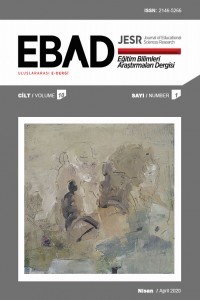Identifying the Relationships Between Perseverance, Openness to Problem Solving, and Academic Success in PISA 2012 Turkey
Identifying, Relationships, Perseverance
Identifying the Relationships Between Perseverance, Openness to Problem Solving, and Academic Success in PISA 2012 Turkey
Students achievement, Perseverance Openness to problem solving, PISA, Quantile regression analysis,
___
- Akın, A., & Arslan, S. (2014). Başarı yönelimleri ile kararlılık arasındaki ilişkiler. Eğitim ve Bilim, 39(175), 267-274.
- Beaty, R., Nusbaum, E., & Silvia, P. (2014). Does insight problem solving predict real-world creativity? Psychology of Aesthetics, Creativity, and the Arts, 8(3), 287-292.
- Blackwell, L. S., Trzesniewski, K. H., & Dweck, C. S. (2007). Implicit theories of intelligence predict achievement across an adolescent transition: A longitudinal study and an intervention. Child Development, 78(1), 246-263.
- Boyce, M. C. (2011). Fostering hope and perseverance in underachieving students through a school-based intervention (Doctoral dissertation). Alliant International University, San Diego.
- Brookhart, S. M. (2010). How to assess higher order thinking skills in your classroom. Virginia, USA: ASCD Member Book.
- Büyüköztürk, Ş., Çakmak, E. K., Akgün, Ö. E., & Karadeniz, Ş. (2008). Bilimsel araştırma yöntemleri. Ankara: Pegem Akademi.
- Chen, F., & Chalhoub-Deville, M. (2014). Principles of quantile regression and an application. Language Testing, 31(1), 63-87.
- Çelik, O., & Selim, S. (2014). Türkiye’de kamu ve özel sektör ücret farklılıklarının kantil regresyon yaklaşımı ile analizi. Yönetim ve Ekonomi, 21(1), 205-232.
- Çiftçi, C., & Kangallı, S. G. (2015). Eğitim ve gelir. Ege Akademik Bakış, 15(1), 141-152.
- Duckworth, A. L., Peterson, C., Matthews, M. D., & Kelly, D. R. (2007). Grit: Perseverance and passion for long term goals. Journal of Personality and Social Psychology, 92(6), 1087–1101.
- Dweck, C. S. (1975). The role of expectations and attributions in the alleviation of learned helplessness. Journal of Personality and Social Psychology, 31(4), 674-685.
- Dweck, C. S. (1999). Self-Theories: Their role in motivation, personality, and development. USA: Taylor & Francis.
- Dweck, C. S. (2006). Mindset: The new psychology of success. New York: Random House.
- Dweck, C. S., & Leggett, E. L. (1988). Social-cognitive approach to motivation and personality. Psychological Review, 95(2), 256-273.
- Hammond, L., & Adamson, F. (2010). Beyond basic skills: The role of performance assessment in achieving 21st century standards of learning. California: The Stanford Center for Opportunity Policy in Education
- Karakaya, İ., & Kutlu, Ö. (2002). Ortaöğretim kurumları öğrenci seçme ve yerleştirme sınavının (okösys) yordama geçerliğine ilişkin bir araştırma. Eğitim Bilimleri ve Uygulama Dergisi, 1(2), 235-247.
- Koenker, R., & Hallock, K. F. (2001). Quantile regression. Journal of Economic Perspectives, 15(4), 143-156.
- Lin, W.-L., Chen, H.-C., Hsu, K.-Y., & Wang, J.-W. (2012). The relations of gender and personality traits on different creativities: A dual-process theory account. Psychology of Aesthetics, Creativity and the Arts, 6(2), 112-123.
- McCutcheon, C. A. (2014). Perseverance and persistence in achieving educational goals: A case study of an adult charter high school examining perseverance of students utilizing a mixed methods approach (Doctoral dissertation). Ball State University, Indiana.
- Ministry of Education. (2015). Insights for teachers: New Zealand students’ self-belief and confidence and implications for achievement. Retrieved from http://apo.org.au/files/Resource/insights-forteachers-nz-student-self-belief.pdf
- Nicholls, J. (1983). Conception of ability and achievement motivation: A theory and its implications for education. In S. Paris, G. Olson, & H. Steveson (Eds.), Learning and motivation in the classroom (pp. 211-237). NJ: Erlbaum Associates.
- OECD. (2013). PISA 2012 results: Ready to learn-students’ engagement, drive and self-beliefs (Volume III). Retrieved from http://www.oecd.org/pisa/keyfindings/PISA-2012-resultsvolume-III.pdf OECD. (2014). Strengthening resilience through education and skills: PISA results. Retrieved from https://www.oecd.org/mcm/Pisa2012_Overview_v25_04_05_14.pdf
- Peterson, C., & Seligman, M. E. P. (2004). Character strengths and virtues: A handbook and classification. Washington, DC: American Psychological Association.
- Philips, D. (1984). The illusion of incompetence among academically competent children. Child Development, 55(6), 2000-2016.
- Scherer, R., & Gustafsson, J. E. (2015). The relations among openness, perseverance and performance in creative problem solving: A substantive methodological approach. Thinking Skills and Creativity, 18, 4-17.
- Schunk, D. H., Pintrich, P. R., & Meece, J. L. (2002). Motivation in education: Theory, research and application. New Jersey: Pearson Education, Inc.
- Stipek, D. (1988). Motivation to learn: From theory to practice. Massachusetts: Allyn & Bacon, Inc. Strayhorn, T. L. (2014). What role does grit play in the academic success of black male collegians at predominantly white institutions? Journal of African American Studies, 18(1), 1-10.
- Tabachnick, B. G., & Fidell, L. S. (2007). Using multivariate statistics. Massachusetts: Allyn & Bacon. Tollefson, N. (2000). Classroom applications of cognitive theories of motivation. Educational Psychology Review, 12(1), 63-83.
- Başlangıç: 2011
- Yayıncı: Kürşad YILMAZ
Reasons for Whistleblowing: A Qualitative Study
Difficulties that Students who Learn Turkish as a Foreign Language Encounter During Listening Skills
Abdullah KALDIRIM, Hikmet DEGEÇ
Reading Culture of Pre-service Turkish Language Teachers: The Case of Muğla Sıtkı Koçman University
Hatice FIRAT, Mustafa Volkan COŞKUN
Furkan AYDIN, Aysun EROĞLU, Mehmet Barış HORZUM
Supervision and the PhD Process: Perspectives of Research Assistants
Determining the Response Behaviors of Middle School Students for Open-Ended Questions
Neslihan Tuğçe ŞİMŞEK, Ömer KUTLU
Gizem UYUMAZ, Ömay ÇOKLUK BÖKEOĞLU
Ömer KUTLU, Seval KULA KARTAL, Neslihan Tuğçe ŞİMŞEK
Why do Students Cheat in Examinations in Turkey? A Meta-Synthesis Study
